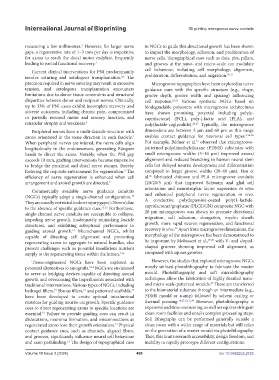Page 498 - IJB-10-3
P. 498
International Journal of Bioprinting 3D printing microgroove nerve conduits
measuring a few millimetres. However, for larger nerve in NGCs to guide this directional growth has been shown
2
gaps, a regenerative rate of 1–3 mm per day is imperative to impact the morphology, adhesion, and proliferation of
for axons to reach the distal motor endplate, frequently nerve cells. Topographical cues such as dots, pits, pillars,
leading to partial functional recovery. 3 and grooves at the nano- and micro-scale can modulate
Current clinical interventions for PNI predominantly cell behaviour, including cell morphology, alignment,
involve suturing and autologous transplantation. The proliferation, differentiation, and migration. 20,21
4,5
precision required in nerve suturing may result in excessive Microgroove topographies have been explored as nerve
tension, and autologous transplantation encounters guidance cues with the specific structure (e.g., shape,
limitations due to donor tissue constraints and structural groove depth, groove width and spacing) influencing
disparities between donor and recipient nerves. Clinically, cell response. 22,23 Various synthetic NGCs based on
up to 33% of PNI cases exhibit incomplete recovery and biodegradable polyesters with microgroove architectures
adverse outcomes, including chronic pain, compromised have shown promising potential including poly(ε-
or partially restored motor and sensory function, and caprolactone) (PCL), poly-l-lactic acid (PLA), and
muscular atrophy and weakness. 6 poly(lactide-coglycolide). 24,25 Typically, the microgroove
Peripheral nerves have a multi-fascicle structure with dimensions are between 5 µm and 60 µm as this range
axons orientated in the same direction in each fascicle. enables contact guidance for neuronal cell types. 9,26-36
7
27
When peripheral nerves are injured, the nerve cells align For example, Béduer et al. observed that microgroove-
longitudinally in the endoneurium, generating Büngner patterned polydimethylsiloxane (PDMS) substrates with
bands to direct the axons. Notably, when the PNI gap small microgroove widths (5–10 µm) improved axonal
exceeds 10 mm, grafting interventions become imperative alignment and reduced branching in human neural stem
to bridge the proximal and distal nerve stumps, thereby cells but delayed neurite development and differentiation
fostering the requisite environment for regeneration. The compared to larger groove widths (20–60 µm). Hsu et
8
26
efficiency of nerve regeneration is enhanced when cell al. fabricated chitosan and PLA microgroove conduits
arrangement and axonal growth are directed. 9 (20/20/3 µm) that improved Schwann and glial cell
orientation and neurotrophic factor expression in vitro
Commercially available nerve guidance conduits
(NGCs) typically adopt a single-channel configuration. and enhanced peripheral nerve regeneration in vivo.
10
A conductive polydopamine-coated poly(L-lactide-
They are usually restricted to short injury gaps (<20 mm) due
to the absence of specific guidance cues. 11,12 Furthermore, caprolactone)/graphene (PLCL/GN) composite NGC with
single-channel nerve conduits are susceptible to collapse, 20 µm microgrooves was shown to promote directional
impeding nerve growth, inadequately mimicking fascicle migration, cell adhesion, elongation, myelin sheath
structures, and exhibiting suboptimal performance in growth, more rapid neuron regeneration, and functional
28
13
guiding axonal growth. Microchannel NGCs, whilst recovery in vivo. Apart from microgroove dimensions, the
capable of directing cell alignment and promoting morphology of the microgroove has been demonstrated to
regenerating axons to aggregate in natural bundles, also be important by Mobasseri et al., 29,30 with V- and sloped-
present challenges such as potential insufficient nutrient shaped grooves showing improved cell alignment, as
supply to the regenerating tissue within the lumen. 5,14 compared with square grooves.
Tissue-engineered NGCs have been explored as However, the studies that explored microgroove NGCs
potential alternatives to autografts. NGCs are envisioned mostly utilised photolithography to fabricate the master
5,14
to serve as bridging devices capable of directing axonal mould. Photolithography and soft microlithography
growth and overcoming the impediments associated with techniques allow the fabrication of highly detailed nano-
37
traditional interventions. Various types of NGCs, including and micro-scale-patterned moulds. These are transferred
hydrogel fillers, fibrous fillers, and patterned scaffolds, to the biomaterial substrate through an intermediate (e.g.,
16
17
15
have been developed to create optimal intraluminal PDMS mould or stamp) followed by solvent casting or
matrices for guiding neurite outgrowth. Specific guidance thermal pressing. 14,27,30,31,38 However, photolithography is
cues to direct regenerating axons to specific locations are expensive and time-consuming, as well as requires stringent
essential. Failure to provide guiding cues can result in clean room facilities and entails complex processing steps.
18
dislocations, neuroma formation, and misconnections as Soft lithography can be performed generally outside a
regenerated axons lose their growth orientation. Physical clean room with a wider range of materials but still relies
19
contact guidance cues, such as channels, aligned fibres, on the generation of a master mould via photolithography.
and grooves, significantly influence neural cell behaviour Thus, this limits research accessibility, design freedom, and
and axon pathfinding. The design of topographical cues inability to rapidly prototype different configurations.
12
Volume 10 Issue 3 (2024) 490 doi: 10.36922/ijb.2725

